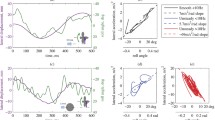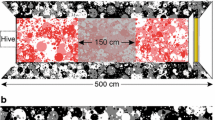Summary
-
1.
Bees were trained to a feeding station, where they obtained a 2-mol sucrose solution. The course of flight led across water and covered a distance of 247 m. The speed of the bees and their path of flight were observed.
-
2.
When the water surface was mirror smooth, a great number of bees plunged into the water. They continually lost altitude until they crashed headlong into the water, wich thereby flipped them onto their backs. We were unable to observe this phenomenon when the water was rippled or, during smooth water, when the course was marked with a bridge of floating boards.
-
3.
The bees always flew slower and lower over rippled water then over solid land or the floating bridge of boards. We measured without wind a flight-speed over water of 6.34 m/s (43 observations), over the floating bridge a flight-speed of 7.93 m/s (11 observations). The difference is significant.
-
4.
The bees compensated for the velocity of the wind when flying over rippled water as well as over the bridge, so that their air-speed was greater when they were flying against the wind and less when they were flying with the wind.
-
5.
The flight across water was disturbed to a great extent by crosswinds. The bees could maintain the correct angle to the cross-wind only near the banks. When they were farther than approximately 20 meters from the bank, they drifted in the wind. Even the presence of the floating bridge did not help them to hold the correct angle to the wind. The bees were driven across the bridge and followed it in a garland-like track on the lee-side.
-
6.
A bee, wich was forced to make a detour to the feeding station did not return by the same route, but chose instead the most direct path to the hive.
-
7.
The reasons for a bee flying slowly when close to the surface of the water are discussed.
Similar content being viewed by others
Literatur
Autrum, H.: Neue Versuche zum optischen Auflösungsvermögen fliegender Insekten. Experientia (Basel) 5, 271–277 (1949).
—, u. M. Stöcker: Verschmelzungsfrequenz im Bienenauge. Z. Naturforsch. 5b, 38–43 (1950).
Baumgärtner, H.: Der Formensinn und die Sehschärfe der Bienen. Z. vergl. Physiol. 7, 56–143 (1928).
Frisch, K. v.: Orientierungsvermögen und Sprache der Bienen. Naturwissenschaften 38, 105–112 (1951).
—, H. Heran u. M. Lindauer: Gibt es in der Sprache der Bienen eine Weisung nach oben oder unten? Z. vergl. Physiol. 35, 219–245 (1953).
—, u. M. Lindauer: Über die Fluggeschwindigkeit der Bienen und über ihre Richtungsweisung bei Seitenwind. Naturwissenschaften 42, 377–385 (1955).
Hassenstein, B.: Die Stärke von optokinetischen Reaktionen auf verschiedene Mustergeschwindigkeiten. Z. Naturforsch. 13b, 1–6 (1958).
—: Optokinetische Wirksamkeit bewegter periodischer Muster. Z. Naturforsch. 14b, 659–674 (1959).
Heran, H.: Versuche über die Windkompensation der Bienen. Naturwissenschaften 42, 132 (1955).
—: Ein Beitrag zur Frage nach der Wahrnehmungsgrundlage der Entfernungsweisung der Bienen. Z. vergl. Physiol. 38, 168–218 (1956).
—: Wahrnehmung und Regelung der Flugeigengeschwindigkeit bei Apis mellifica L. Z. vergl. Physiol. 42, 103–163 (1959).
Hocking, B.: The intrinsic range and speed of flight of Insects. Trans. roy. Soc. ent. Soc. 104, 223–345 (1953).
Kennedy, J. S.: The visual responses of flying Mosquitoes. Proc. zool. Soc. (Lond.), Ser. A 109, 221–242 (1939).
Kunze, P.: Untersuchungen des Bewegungssehens fliegender Bienen. Z. vergl. Physiol. 44, 656–684 (1961).
Mittelstaedt, H.: Physiologie des Gleichgewichtssinnes bei fliegenden Libellen. Z. vergl. Physiol. 32, 422–463 (1950).
Pätau, K.: Zur statistischen Beurteilung von Messungsreihen. Biol. Zbl. 63, 152–168 (1943).
Pain, J., et F. Ruttner: Les extraits de glandes mandibulaires des reines d'Abeilles attirent les mâles, lors du vol nuptial. C. R. Acad. Sci. (Paris) 256, 512–515 (1963).
Portillo, J. del: Beziehungen zwischen den Öffnungswinkeln der Ommatidien, Krümmung und Gestalt der Insektenaugen und ihrer funktionellen Aufgabe. Z. vergl. Physiol. 23, 100–146 (1936).
Schaller, F.: Die optomotorische Komponente bei der Flugsteuerung der Insekten. Zool. Beitr., N. F. 5, 483–496 (1960).
Author information
Authors and Affiliations
Additional information
Mit Unterstützung durch Mittel der Rockefeller-Foundation, die uns Herr Prof. K. v. Frisch überließ.
Rights and permissions
About this article
Cite this article
Heran, H., Lindauer, M. Windkompensation und Seitenwindkorrektur der Bienen beim Flug über Wasser. Zeitschrift für vergleichende Physiologie 47, 39–55 (1963). https://doi.org/10.1007/BF00342890
Received:
Issue Date:
DOI: https://doi.org/10.1007/BF00342890




